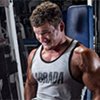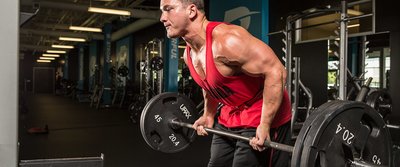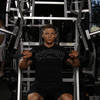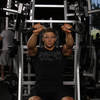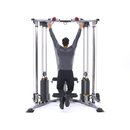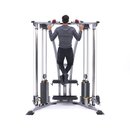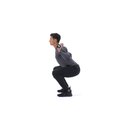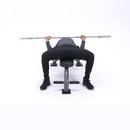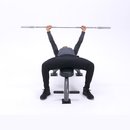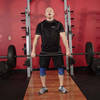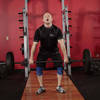Different goals come with their own sets of rules. Want to get strong? Then eat and train for strength! The same goes for adding muscle or losing fat. You can try to have it all or do what's never been done, but the most effective way to burn a maximum amount of fat is to train and eat with that singular goal in mind.
I recently discussed the rules for eating to lose fat in the article "Fat to Fit: Hunter Labrada's Definitive Guide to Weight Loss." Whether you're male or female, a professional athlete or weekend warrior, need desperately to lose 50 pounds or just want to lose 5, the most important component to achieving your ideal body is your diet. But make no mistake: How you train matters, too!
Don't just trust that the same old plan you followed before will keep working now. If you're just getting started, have hit a plateau, or even want to ramp up the intensity of your cut (props to you!), this is the methodology I personally use for maximal fat loss with minimal muscle loss. I'm confident it will work for you!
You don't want to just lose weight
Huge transformations where people drop hundreds of pounds and totally transform their lives get lots of attention—and rightfully so. But I would argue that we can learn just as much from a very different type of transformation. I'm talking about the ones where an individual only loses a few pounds on the scale, but the "before" and "after" pictures show a world of visual difference.
What happened here? This person changed their body composition, as opposed to indiscriminately losing weight. Losing weight is typically what happens when one tries to lose body fat by crash dieting and doing totally excessive amounts of cardio—in other words, the way society normally sees dieting. Yes, you will lose weight doing this, but you'll burn as much muscle as fat. In the end, you might end up a smaller you with relatively the same body fat. This is a recipe for disappointment!

Different goals come with their own sets of rules.
So let's set some priorities. You want to lose fat, not just weight, while keeping your lean body mass (LBM) relatively stable. Do this, and you'll actually reduce your body-fat percentage, feel better, and look better, rather than just changing the number on the scale.
So how do you make these priorities a reality? With weight training! Here's how muscle helps you lose fat.
Weight training promotes muscle-tissue growth. The more muscle tissue you have, the more energy your body is burning to support it! The more calories you burn to support muscle tissue, the leaner you'll get. You may have heard people say that muscle is "metabolically active" tissue, but here's another way to think about it: Muscle is calorically intensive tissue.
Weight training, especially the kind that is intense enough to result in muscle growth (hypertrophy), promotes increased testosterone and growth-hormone production in your body. This is a good thing for both men and women—so don't fear it, ladies! Both of these hormones aid and accelerate fat loss. They're also anabolic (muscle-building) in nature, and can help you preserve more muscle mass when dieting.
Weight training elevates your metabolism for some time after your session ends due to excess post-exercise oxygen consumption (EPOC). Put simply, after weight training, your body continues to consume oxygen at an accelerated rate as it works to normalize your hormones, temperature, and heart rate, and replenish energy stores. As your body performs all these functions, it expends considerably more energy even at rest, which leads to more fat loss!
There's a time for strength and a time for reps
So let's all go push around the heaviest barbells we can find for as many sets as possible, right? Not quite. Just like training for strength, training for fat loss has its own set of rules, and you should adjust your expectations for your training sessions.
As I discussed in my nutritional guide to fat loss, when trying to lose body fat, you'll be in a caloric deficit. Your body will not have as much energy as normal, and subsequently, you might not be able to lift as much weight in the gym. For this reason, this is no time to push for personal records or near-maximal lifts.
You should aim to strike a balance between keeping your workouts intense, but not beating your body into the dirt with heavy weights, excessive volume, or the total number of sets and reps you perform per workout. These pitfalls will place an undue amount of stress on your body during a time when it isn't at full strength in terms of recovery ability.

You should aim to strike a balance between keeping your workouts intense, but not beating your body into the dirt with heavy weights, excessive volume, or the total number of sets and reps you perform per workout.
My rule of thumb is, when training for fat loss, you should reduce the number of sets you perform to about 75 percent of what you were doing before. In my case, this means about 12 sets maximum per body part, and even fewer for smaller muscles such as biceps, triceps, and shoulders.
So how do you keep your workouts intense if you reduce overall volume and weight used, you ask? By manipulating the other components of what I like to refer to as the "exercise intensity equation:"
Exercise Intensity = (Volume x Reps x Weight used)/Rest time
As you can see, the other aspects of the equation are repetitions and rest time. When cutting, using a higher rep range of 12-20 reps per set will allow you to train your muscles with less weight, tax your central nervous system less, and tax your cardiovascular system more. Your heart rate will go way up and your glycogen stores will be close to depleted, making it easier for your body to switch to burning fat for energy.
Decreasing rest time and maintaining a blistering workout pace enhances those same benefits even more. I personally aim to rest no longer than it takes my partner to do a set, usually about 45 seconds. Any longer, and you're doing yourself a disservice. If you have a chatty workout partner or like surfing the latest Instagram posts between sets, you'll definitely have some adjustments to make!
Full-body movements for full-body fat-loss
You may think that working in a 12-20 rep range means you'll only be doing isolation movements like kick-backs, side laterals, and leg extensions. Far from it! The exercises most conducive to losing body fat are multijoint, compound movements like squat and deadlift variations, pull-ups, the bench press and overhead press, and full-body explosive movements like power cleans or hang cleans.
These types of movements recruit multiple muscle groups, causing your body to burn far more energy than it would performing isolation exercises. Also, because you're going to reduce the total number of sets, you'll end up neglecting some body parts if you train only with isolation exercises.
Here's a sample of what my personal training routine looks like when I'm trying to cut body fat. Keep in mind that, since I'm training to be a competitive bodybuilder, I tend to avoid movements like power cleans, hang cleans, and push presses. The risk-to-reward ratio for injury just doesn't make sense for me to do at my size, nor is my body conditioned to perform explosive movements like it was back in my football days.
However, I've also included an "explosive" program for lifters who are familiar with these movements and comfortable performing them.
Hunter Labrada's Fat-Loss Program
All of these workouts are designed to be performed in 50 minutes or less. Train two days in a row, followed by a rest day. Follow the program for 4-8 weeks as needed. Here's how it could look over the course of a week:
- Monday: Workout A
- Tuesday: Workout B
- Wednesday: Rest day
- Thursday: Workout C
- Friday: Workout A
- Saturday: Rest day
- Sunday: Workout B

BodyFit
$6.99/month- 2,500+ expert-created single workouts
- 3,500+ how-to exercise videos
- Detailed workout instruction
- Step-by-step workout tips
- Training at gym or at home
- Access to Workout Plans
- Access to Bodyfit App
- Store Discounts
Already have a Bodybuilding.com account with BodyFit? Sign In

What comes with BodyFit?

- Instructional Videos
Don't risk doing a workout improperly! Avoid injury and keep your form in check with in-depth instructional videos.

- How-to Images
View our enormous library of workout photos and see exactly how each exercise should be done before you give it a shot.

- Step-by-Step Instructions
Quickly read through our step-by-step directions to ensure you're doing each workout correctly the first time, every time.

BodyFit
$6.99/month- 2,500+ expert-created single workouts
- 3,500+ how-to exercise videos
- Detailed workout instruction
- Step-by-step workout tips
- Training at gym or at home
- Access to Workout Plans
- Access to Bodyfit App
- Store Discounts
Already have a Bodybuilding.com account with BodyFit? Sign In

What comes with BodyFit?

- Instructional Videos
Don't risk doing a workout improperly! Avoid injury and keep your form in check with in-depth instructional videos.

- How-to Images
View our enormous library of workout photos and see exactly how each exercise should be done before you give it a shot.

- Step-by-Step Instructions
Quickly read through our step-by-step directions to ensure you're doing each workout correctly the first time, every time.

BodyFit
$6.99/month- 2,500+ expert-created single workouts
- 3,500+ how-to exercise videos
- Detailed workout instruction
- Step-by-step workout tips
- Training at gym or at home
- Access to Workout Plans
- Access to Bodyfit App
- Store Discounts
Already have a Bodybuilding.com account with BodyFit? Sign In

What comes with BodyFit?

- Instructional Videos
Don't risk doing a workout improperly! Avoid injury and keep your form in check with in-depth instructional videos.

- How-to Images
View our enormous library of workout photos and see exactly how each exercise should be done before you give it a shot.

- Step-by-Step Instructions
Quickly read through our step-by-step directions to ensure you're doing each workout correctly the first time, every time.
Alternate program Explosive workouts
All of these workouts are designed to be performed in 50 minutes or less. Train two days in a row, followed by a rest day. Follow the program for 4- 8 weeks as needed. Here's how it could look over the course of a week:
- Monday: Workout A
- Tuesday: Workout B
- Wednesday: Rest day
- Thursday: Workout C
- Friday: Workout A
- Saturday: Rest day
- Sunday: Workout B

BodyFit
$6.99/month- 2,500+ expert-created single workouts
- 3,500+ how-to exercise videos
- Detailed workout instruction
- Step-by-step workout tips
- Training at gym or at home
- Access to Workout Plans
- Access to Bodyfit App
- Store Discounts
Already have a Bodybuilding.com account with BodyFit? Sign In

What comes with BodyFit?

- Instructional Videos
Don't risk doing a workout improperly! Avoid injury and keep your form in check with in-depth instructional videos.

- How-to Images
View our enormous library of workout photos and see exactly how each exercise should be done before you give it a shot.

- Step-by-Step Instructions
Quickly read through our step-by-step directions to ensure you're doing each workout correctly the first time, every time.

BodyFit
$6.99/month- 2,500+ expert-created single workouts
- 3,500+ how-to exercise videos
- Detailed workout instruction
- Step-by-step workout tips
- Training at gym or at home
- Access to Workout Plans
- Access to Bodyfit App
- Store Discounts
Already have a Bodybuilding.com account with BodyFit? Sign In

What comes with BodyFit?

- Instructional Videos
Don't risk doing a workout improperly! Avoid injury and keep your form in check with in-depth instructional videos.

- How-to Images
View our enormous library of workout photos and see exactly how each exercise should be done before you give it a shot.

- Step-by-Step Instructions
Quickly read through our step-by-step directions to ensure you're doing each workout correctly the first time, every time.

BodyFit
$6.99/month- 2,500+ expert-created single workouts
- 3,500+ how-to exercise videos
- Detailed workout instruction
- Step-by-step workout tips
- Training at gym or at home
- Access to Workout Plans
- Access to Bodyfit App
- Store Discounts
Already have a Bodybuilding.com account with BodyFit? Sign In

What comes with BodyFit?

- Instructional Videos
Don't risk doing a workout improperly! Avoid injury and keep your form in check with in-depth instructional videos.

- How-to Images
View our enormous library of workout photos and see exactly how each exercise should be done before you give it a shot.

- Step-by-Step Instructions
Quickly read through our step-by-step directions to ensure you're doing each workout correctly the first time, every time.
Personalize your fat-loss cardio
Cardio is where things go wrong for a lot of people. On one hand, yes, cardio can accelerate fat loss. But on the other hand it can be boring, time-consuming, and burn a whole lot of muscle if done wrong.
So what's "wrong" cardio? Simply doing as much as you can handle, with no particular plan or personalization. Unlike your weight training, which can be effective while still following a fairly universal approach, your cardio needs to be based on your goals—namely, how much fat you want to lose.

For most people, I recommend a blend of steady-state cardio and high-intensity intervial training (HIIT).
For most people, I recommend a blend of steady-state cardio and high-intensity intervial training (HIIT). Steady-state cardio is when you perform your cardio activity of choice at a steady pace that elevates your heart rate to between 55 and 75 percent of your maximum heart rate, or MHR. To find your MHR, perform the following calculation: 220 - your age (in years).
Once you know your MHR, stay within the aforementioned range of 55-75 percent of it for the entire duration of your cardio session. Get a heart-rate monitor with alarms if it helps you stay on course.
HIIT, on the other hand, involves performing very intense "sprint" intervals, alternated with lower, more moderate-intensity recovery periods. HIIT is the preferred form of cardio for most athletes, and has proven to be very effective. Because of how intense HIIT can be, you experience significant fat burning even after the cardio session is completed, through the same mechanisms as lifting weights.
Usually, I base my cardio recommendations on three categories: People who have 7 percent or more body fat to lose, 4-7 percent body fat to lose, or 1-3 percent.
What cardio activity is best?
Put simply, whatever you enjoy and works for your body is the best choice! Here are some options:
Steady-state
- Fast walking
- Hiking
- Swimming
- Jogging
- Cycling
- Jumping rope
- Rowing
- Stair climber (steady pace)
- Inline skating
- Sports (tennis, golf, basketball)
HIIT
- Cycle sprints
- Flat sprints
- Hill sprints
- Stair-climber intervals
- Jump-rope intervals
- Double-unders
- Rower sprints
- Circuits and complexes
Goal 1. More than 7-percent fat loss
If you need to lose 7 percent or more body fat, chances are you're not in the best cardiovascular shape. Because of this, you're going to use a program that uses steady-state cardio to give you a base of conditioning before switching to HIIT to kick fat-burning into high gear once you're ready.
For Weeks 1-4, perform cardio at least five times per week, preferably in the morning. Once you enter Week 5, and for as long as you follow my fat-loss plan, perform HIIT cardio 3-4 times a week, depending on how recovered your body feels.
There are many different HIIT protocols you can choose from, but here's the one I prefer: Perform 30 seconds of max-effort work, followed by 60 seconds of low-to-medium effort. Give yourself four-minute warm-up and cooldown periods.
Morning
- Weeks 1-2, 20 min. steady-state
- Weeks 3-4, 30 min. steady-state
- Weeks 5-6, 30 min. steady-state
- Weeks 7-8, 30 min. steady-state
Post-training
- Weeks 1-2, 20 min. steady-state
- Weeks 3-4, 30 min. steady-state
- Weeks 5-6, 8 HIIT intervals
- Weeks 7-8, 10 HIIT intervals
Goal 2. 4-7 percent fat loss
If you have 4-7 percent body fat to lose before you reach your goal, we want to focus on preserving muscle mass, while still shedding as much fat as quickly as possible.
To do this, the first two weeks of the program will include 30 minutes of steady-state cardio every morning. After that, perform 10 intervals after training for three days per week for the remainder of the weeks you follow the plan.
Morning
- Weeks 1-2, 30 min. steady-state daily
- Weeks 3+, no morning cardio
Post-training
- Weeks 1-2, 10 HIIT interval 3 times per week
- Weeks 3+, 10 HIIT intervals every other day
Goal 3. 1-3 percent fat loss
If you have ony 1-3 percent body fat remaining for you to reach your goal, chances are you are already in relatively good shape and are quite lean. Because of this, our focus shifts from burning fat quickly to burning fat while minimizing muscle loss. Because you body is already burning fat from the caloric deficit provided by your diet, your muscular body composition, and the intense weightlifting component of your training, you only need minimal cardio to reach your goal.
With this in mind, I would recommend 10 HIIT intervals 2-3 times per week or, if you are following the example workouts provided in this article, on every other day.
The rest is up to you
I know how intimidating the project of losing fat and redefining your body composition can be—especially on the front end. All this information can seem like a lot to take in, and if you are on the fence or unsure if you'll be able to stick it out, that's normal.
My suggestion is to do yourself the biggest favor you can: Cast aside those doubts, and do your best to enjoy the ride! Once you start seeing your body change—and just as importantly, realizing how great it feels not to do it the crash-diet way—it'll get easier. Then one day, it becomes your lifestyle.
If you have any questions for me, be sure to drop them in the comments. Let's do this together!
